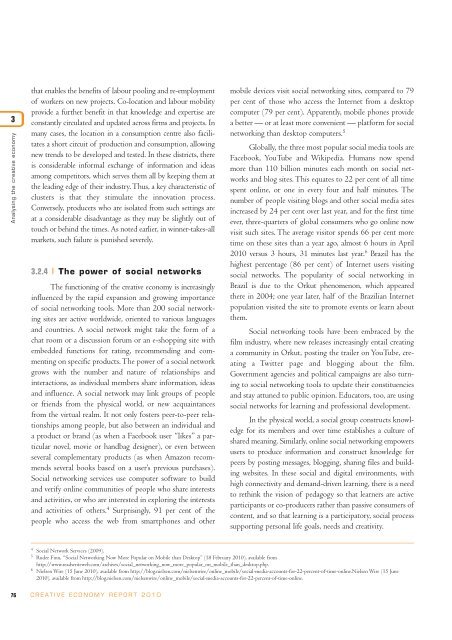Creative Economy: A Feasible Development Option
Creative Economy: A Feasible Development Option
Creative Economy: A Feasible Development Option
- No tags were found...
You also want an ePaper? Increase the reach of your titles
YUMPU automatically turns print PDFs into web optimized ePapers that Google loves.
3Analysing the creative economythat enables the benefits of labour pooling and re-employmentof workers on new projects. Co-location and labour mobilityprovide a further benefit in that knowledge and expertise areconstantly circulated and updated across firms and projects. Inmany cases, the location in a consumption centre also facilitatesa short circuit of production and consumption, allowingnew trends to be developed and tested. In these districts, thereis considerable informal exchange of information and ideasamong competitors, which serves them all by keeping them atthe leading edge of their industry. Thus, a key characteristic ofclusters is that they stimulate the innovation process.Conversely, producers who are isolated from such settings areat a considerable disadvantage as they may be slightly out oftouch or behind the times. As noted earlier, in winner-takes-allmarkets, such failure is punished severely.3.2.4 The power of social networksThe functioning of the creative economy is increasinglyinfluenced by the rapid expansion and growing importanceof social networking tools. More than 200 social networkingsites are active worldwide, oriented to various languagesand countries. A social network might take the form of achat room or a discussion forum or an e-shopping site withembedded functions for rating, recommending and commentingon specific products. The power of a social networkgrows with the number and nature of relationships andinteractions, as individual members share information, ideasand influence. A social network may link groups of peopleor friends from the physical world, or new acquaintancesfrom the virtual realm. It not only fosters peer-to-peer relationshipsamong people, but also between an individual anda product or brand (as when a Facebook user “likes” a particularnovel, movie or handbag designer), or even betweenseveral complementary products (as when Amazon recommendsseveral books based on a user’s previous purchases).Social networking services use computer software to buildand verify online communities of people who share interestsand activities, or who are interested in exploring the interestsand activities of others. 4 Surprisingly, 91 per cent of thepeople who access the web from smartphones and othermobile devices visit social networking sites, compared to 79per cent of those who access the Internet from a desktopcomputer (79 per cent). Apparently, mobile phones providea better — or at least more convenient — platform for socialnetworking than desktop computers. 5Globally, the three most popular social media tools areFacebook, YouTube and Wikipedia. Humans now spendmore than 110 billion minutes each month on social networksand blog sites. This equates to 22 per cent of all timespent online, or one in every four and half minutes. Thenumber of people visiting blogs and other social media sitesincreased by 24 per cent over last year, and for the first timeever, three-quarters of global consumers who go online nowvisit such sites. The average visitor spends 66 per cent moretime on these sites than a year ago, almost 6 hours in April2010 versus 3 hours, 31 minutes last year. 6 Brazil has thehighest percentage (86 per cent) of Internet users visitingsocial networks. The popularity of social networking inBrazil is due to the Orkut phenomenon, which appearedthere in 2004; one year later, half of the Brazilian Internetpopulation visited the site to promote events or learn aboutthem.Social networking tools have been embraced by thefilm industry, where new releases increasingly entail creatinga community in Orkut, posting the trailer on YouTube, creatinga Twitter page and blogging about the film.Government agencies and political campaigns are also turningto social networking tools to update their constituenciesand stay attuned to public opinion. Educators, too, are usingsocial networks for learning and professional development.In the physical world, a social group constructs knowledgefor its members and over time establishes a culture ofshared meaning. Similarly, online social networking empowersusers to produce information and construct knowledge forpeers by posting messages, blogging, sharing files and buildingwebsites. In these social and digital environments, withhigh connectivity and demand-driven learning, there is a needto rethink the vision of pedagogy so that learners are activeparticipants or co-producers rather than passive consumers ofcontent, and so that learning is a participatory, social processsupporting personal life goals, needs and creativity.4 Social Network Services (2009).5 Ruder Finn, “Social Networking Now More Popular on Mobile than Desktop” (18 February 2010), available fromhttp://www.readwriteweb.com/archives/social_networking_now_more_popular_on_mobile_than_desktop.php.6 Nielsen Wire (15 June 2010), available from http://blog.nielsen.com/nielsenwire/online_mobile/social-media-accounts-for-22-percent-of-time-online.Nielsen Wire (15 June2010), available from http://blog.nielsen.com/nielsenwire/online_mobile/social-media-accounts-for-22-percent-of-time-online.76 CREATIVE ECONOMY REPORT 2010
















